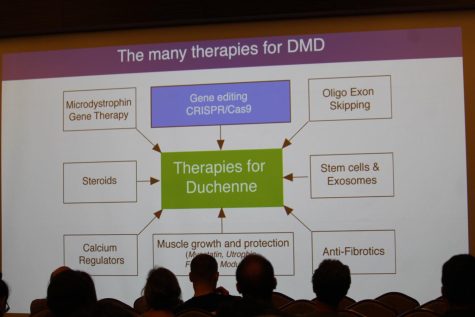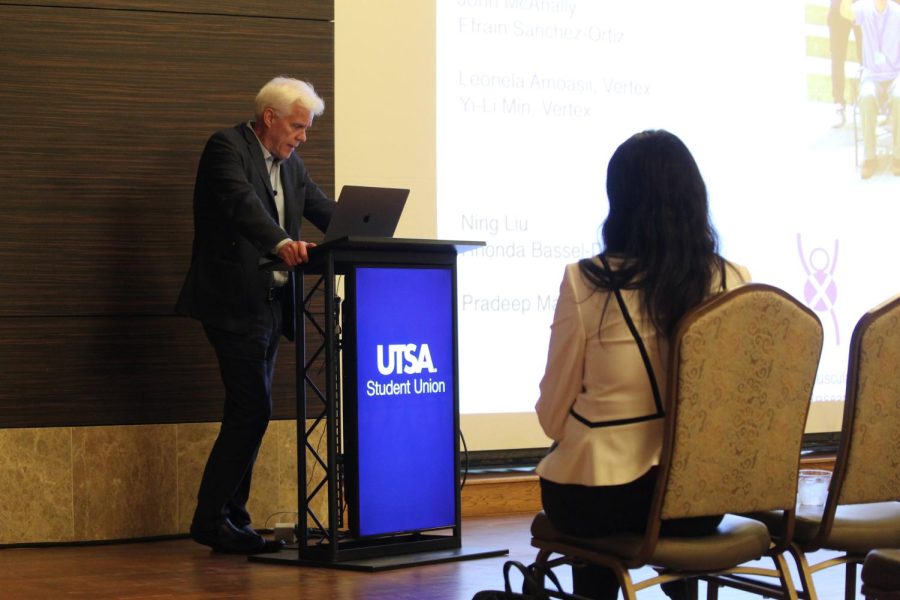Spring 2022 Distinguished Public Lecture – Dr. Eric Olson and CRISPR-Cas9 gene editing
May 5, 2022
On Monday, April 25, UTSA’s Neurosciences Institute & Brain Health Consortium presented the Spring 2022 Distinguished Public Lecture. Eric Olson, Ph.D., the professor and chair of the UT Southwestern Medical Center led the presentation on CRISPR-Cas9 technology and the advancements it has made in neuromuscular and heart diseases.
Dr. Olson began his presentation by demonstrating the importance of muscle in living organisms. He claimed that muscle provides the meaning of life, and that there is no life without muscle. Following this, he presented the many genetic mutations that cause muscle malfunctions and diseases.
“There are hundreds of diseases of muscle tissues in humans, caused by mutations in genes with very diverse functions, and there’s not a single cure for any of them. The most devastating of all muscle diseases is Duchenne muscular dystrophy,” Dr. Olson said. “This disease has been known for more than 150 years since it was first identified around the 1870s by a French neurologist [named] Duchenne.”
Dr. Olson also noted that Duchenne is essentially an incurable chronic illness found in boys that is almost always met by premature death.
“No patient with Duchenne has ever escaped this subsequent series of clinical events. The degeneration of muscles in these boys leads to their confinement from wheelchair to … then lose use of their arms and they require ventilation because the diaphragm is a muscle that’s required for breathing, ultimately, and this leads [to] heart failure and death by [their] mid 20s,” Dr. Olson said.

But thanks to the CRISPR-Cas9 gene editing breakthrough, test subjects with muscular dystrophy that have been genetically altered have shown significant success. CRISPR-Cas9 allows medical professionals to alter the DNA of a living organism. This technology has been used previously by He Jiankui, a Chinese geneticist, who genetically edited a set of twins who had a hereditary predisposition to HIV. Jiankui’s successful experiment with the twins was met by immense controversy in 2018, but now, Dr. Olson is testing this miraculous innovation on young boys with a rare muscular disease.
After CRISPR’s noteworthy results in previous subjects, Dr. Olson and his team experimented with dogs that had Duchenne.
“We wanted to ask ‘Could we really do this in a large animal beyond a mouse?’ A lot of diseases had been cured in mice and … so we searched the world over, and we found that [at] the Royal Veterinary College in London, [was] a family of dogs that had the exon 50 deletion in dystrophin, the most commonly deleted exon in boys with Duchenne, and the exon that we’ve already corrected in human cells in the myosin. This original dog was owned by an elderly lady in London — it was her favorite dog and the dog was having trouble getting up and down the stairs,” Dr. Oslon said. He then shared a short video clip displaying the pups running both before and after the gene editing occurred. Before, the dogs were clearly hindered in their abilities, almost hopping rather than running, but after, they seemed to run almost the exact same as a normal animal would.
The only downside to the treatment is the expenses it requires to conduct.
“The general thought is for genetic therapies that are one-time therapies for the rest of someone’s life – that probably would be in the range of $1 million. And that price … will come down. But the basis for the pricing of these gene therapies is all based on the manufacturing costs for producing the virus. So as people come up with better viruses … those costs will come down considerably,” Dr. Olson said.
For informational videos regarding Dr. Olson and his work, visit the following YouTube links.
https://www.youtube.com/watch?v=11l5jANLjAQ, https://www.youtube.com/watch?v=bMLuERSGd8g, https://www.youtube.com/watch?v=eCvYT-XvD3M, https://www.youtube.com/watch?v=5oulMwwtyaM.







